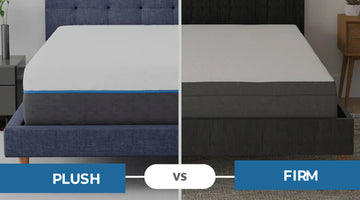Choosing the right mattress is essential. It affects your sleep and overall health. Plush and firm mattresses are conquering the market with their sleep-supporting features. When it's time to choose your bedding mattress you need to be aware of all the aspects including the construction, material, core features, concerns, average age, and, problems associated with the type of mattress you are going to select for the bed set. Each offers different levels of comfort and support. Understanding these differences helps you pick the best fit. This guide explains both types in detail.
Plush Mattress - A Detailed Overview
A plush mattress feels soft and cozy. It gives a cloud-like sleeping experience. You gently sink into the surface. This type is linked to luxury and comfort.
Construction and Material of Plush Mattress
Plush mattresses come with thick comfort layers. Memory foam mattresses are a common material. It molds your body and relieves pressure. Latex is another popular option. It adds bounce and keeps the mattress breathable. Latex comes in both natural and synthetic forms. Pillow tops or Euro tops add extra softness. These layers often use foam or fiberfill for extra cushioning. Hybrid models include pocketed coils. These coils reduce motion transfer and add support. High-density foams form the base. They make the mattress durable and supportive. Combined, these materials create a soft, body-hugging surface. This promotes relaxation and eases pressure points.
The Core Features of Plush Mattress
Plush mattresses feel soft and luxurious. They offer superior comfort with a cozy feel. Thick comfort layers cushion key pressure points. This provides excellent pressure relief. Motion isolation is another key benefit. Movements don’t transfer easily, making them great for couples. The luxurious feel adds a touch of indulgence to your sleep.
Some Concerns About Plush Mattress
Despite their comfort, plush mattresses have drawbacks. They may not support heavier individuals well. Excess sinking can lead to spine misalignment. Memory foam can trap heat, causing overheating. The softness can also make it hard to move or change positions. Edge support tends to be weaker. This makes the edges less reliable for sitting or sleeping.
Who Should Use Plush Mattress?
Plush mattresses suit lightweight sleepers who prefer softness. They are ideal for side sleepers. The soft layers relieve pressure on the hips and shoulders. This is the reason they are also known as soft mattresses. Anyone who enjoys a "cloud-like" feel will love them. Couples benefit from the minimal motion transfer.
Who Should Not Use Plush Mattress?
Heavier individuals may need firmer support. Plush mattresses might not be the best choice. Stomach sleepers also need firmer surfaces for proper alignment. People with back pain should opt for firmer options. Hot sleepers may find plush mattresses too warm due to heat retention. When selecting the best plush mattress keep your mind updated with all these aspects.
When to Replace a Plush Mattress?
Replace a plush mattress when sagging or deep indentations appear. If you experience discomfort or the mattress feels different, it’s time for a change. Generally, plush mattresses should be replaced after 7–8 years.
Firm Mattress - A Detailed Overview
Firm mattresses provide strong support. They reduce sinking and keep your spine aligned. This makes them great for back support and overall stability.
Construction and Material of Firm Mattress
Firm mattresses are built with a few key materials. High-density foam forms a solid base for stability. Innerspring coils add strong support and improve durability. Thin comfort layers keep the surface firm. Dense latex boosts firmness and responds well to body movements. Together, these materials provide a stable surface. They prevent sinking and keep the spine aligned.
The Core Features of Firm Mattress
Firm mattresses promote good posture. They keep your spine aligned. The surface stays stable and supportive. These mattresses tend to last longer than plush ones. Firm edges offer better support for sitting and sleeping near the sides.
Some Concerns About Firm Mattress
Firm mattresses have some downsides. They may feel uncomfortable for side sleepers due to pressure points. Lightweight sleepers might find them too hard. Innerspring coils can transfer motion, disturbing sleep. It might take time to get used to the firmness.
Who Should Use Firm Mattress?
Firm mattresses work well for heavier sleepers needing extra support. Stomach sleepers benefit because firm surfaces keep hips aligned. They’re great for back sleepers who need lumbar support. People with back pain also benefit from a firm base.
Who Should Not Use Firm Mattress?
Firm mattresses aren’t for everyone. Lightweight sleepers who like softness should avoid them. Side sleepers needing pressure relief might feel uncomfortable. People who prefer a plush, cushioned feel won’t find them suitable.
When to Replace a Firm Mattress?
Replace a firm mattress if you see sagging or deep dents. Growing discomfort during sleep is another sign. If the mattress feels different, it might be time for a change. Generally, replace firm mattresses after 8–10 years.
Read More: Twin vs Full Bed
Plush vs. Firm Mattress: Which is More Reliable?
Reliability depends on personal needs. Firm mattresses may be more reliable for heavier individuals or those with back pain. Plush mattresses are more reliable for lighter sleepers or side sleepers who need pressure relief.
Which is More Affordable: Plush or Firm Mattress?
Firm innerspring mattresses are usually cheaper. Plush models with memory foam or latex layers cost more. However, the price varies by brand and construction.
Plush vs. Firm Mattress: Which Lasts Longer?
Firm mattresses, especially innerspring types, typically last longer. Their dense materials add to their durability. However, proper care extends the lifespan of both types.
Which is Ideal for Back Pain? Plush or Firm?
Firm mattresses are generally best for back pain. They offer the support needed for spinal alignment. Medium-firm or hybrid mattresses may also work well. For personalized advice, consult a healthcare provider or sleep expert.
Suggested More: How To Use Mattress Toppers To Relief Back Pain?
FAQs
What features differentiate plush mattresses from firm mattresses?
A plush mattress feels soft and cloud-like. It has thick comfort layers that relieve pressure. A firm mattress, on the other hand, offers solid support. It helps keep the spine aligned and provides better stability.
Who is ideal and who is not ideal for the Plush and Firm mattress?
Plush mattresses are great for lightweight sleepers. They’re also ideal for side sleepers. They make them feel soft, cozy, and extra pressure relief. However, heavier sleepers should go with firm mattresses. Stomach sleepers and those with serious back pain Should also go with the firm mattress.
For whom a firm mattress works better than a plush mattress?
Firm mattresses work best for heavier people. They’re also good for stomach and back sleepers who need proper spinal support. Lightweight and side sleepers may find them too hard. People who prefer a softer feel might also feel uncomfortable with them.
What is the average age of a plush and firm mattress?
Plush mattresses usually last around 7 to 8 years. Firm mattresses, especially innerspring ones, can last 8 to 10 years. It is an approximate age and you suggested to replace your mattress if you found it feasible.
Can a firm mattress relieve back pain?
mattresses are generally better for back pain. They provide the support needed to keep the spine properly aligned. Medium-firm or hybrid mattresses can also help. However, it’s best to consult a healthcare provider for tailored advice.
More Details: 5 Signs You Should Replace Your Mattress Immediately




